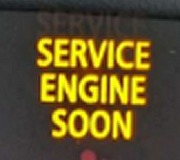Nope. The Transmission Computer stores diagnostic fault codes but there is no dash light to tell you when that happens, so they use code 700 in the Engine Computer, and its "Check Engine" light to tell you. Many auto parts stores use inexpensive code readers that can only access the Engine Computer. You were fortunate that the people at your store use a scanner or code reader that can read fault codes in other computers.
In this case the codes refer to slippage in one of the clutch packs. That can be very minor but it is detected by the computer which sets the codes, then puts the system in "limp" mode. That is where it stays in second gear. That will cause the engine to run much faster than normal above about 25 to 30 mph, and is likely the reason for the unusual noise.
Limp mode is designed only to allow you to drive the vehicle slowly to a repair shop without needing a tow truck. Sustained highway speeds will likely damage the engine. You have to turn the ignition switch off, then restart the engine to get it out of limp mode. Since the fault code refers to slippage in third gear, it should start out in first gear like normal, then shift to second, again like normal. It can go into limp mode when it tries to up-shift into third gear or it could be when down-shifting from fourth gear when you're slowing down.
If the clutch plates are worn and are the cause of the slipping, the problem is going to get progressively worse over the next few weeks or months. You may have periods where it continues to shift properly for hours or days. If you can determine a pattern to identify when the problem occurs, you may be able to work around it for a while. In this case, the slippage might occur when second gear is just being released and third gear is about to lock up and engage. If you know that's when it is likely to occur, accelerate a little faster to make it delay the speed that it up-shifts into third gear, then let off the accelerator a little to reduce the torque, or stress, and lessen the likelihood of that slippage taking place. Third gear will be locked up after a few seconds, then you can continue to accelerate without any slippage occurring. Ford has been doing this electronically for many years because their transmissions aren't strong enough to handle normal acceleration. It's a weird feeling and can be rather irritating but it's what they had to do to make their transmissions hold up.
Part of the problem is this clutch plate wear takes place in every single automatic transmission on every brand of car, but years ago we had a year or two of warning in the form of increasingly sloppy shifts and engine "runaway", meaning it would momentarily speed up a lot during the shifts. The difference was there were no computers involved. There was no limp mode, and we had a year or two of warning that the transmission would need to be rebuilt.
Chrysler was the first to use this computer-controlled design in the '89 models. One of the advantages is the computer can detect how much the clutch plates have worn, and it changes the timing of the shifts so, in this case, it delays when it releases second gear and it engages third gear a little sooner. That overlap masks the sloppy shift feel and makes it feel like it's a brand new vehicle, ... Until the day comes when it can't update any further. That's when the slippage is more than the computer can adjust for, a little slippage occurs, and it goes into limp mode. By updating the shift schedules every time you drive it, you always have nice crisp shifts until the wear is too much to overcome. Then you have no warning of the wear that's occurring like we did many years ago. One day it shifts like a new car, the next day it goes into limp mode.
A mechanic with Chrysler's DRB3 scanner or something similar can read the "clutch volume index", (CVI). That's a set of four numbers corresponding the number of ccs of fluid it takes to apply each clutch pack. Based on those numbers, an experienced transmission mechanic can see the percentage of life remaining in each clutch pack, and give you an idea on about how long it will be before the transmission needs to be rebuilt.
Tuesday, July 15th, 2014 AT 8:25 PM


